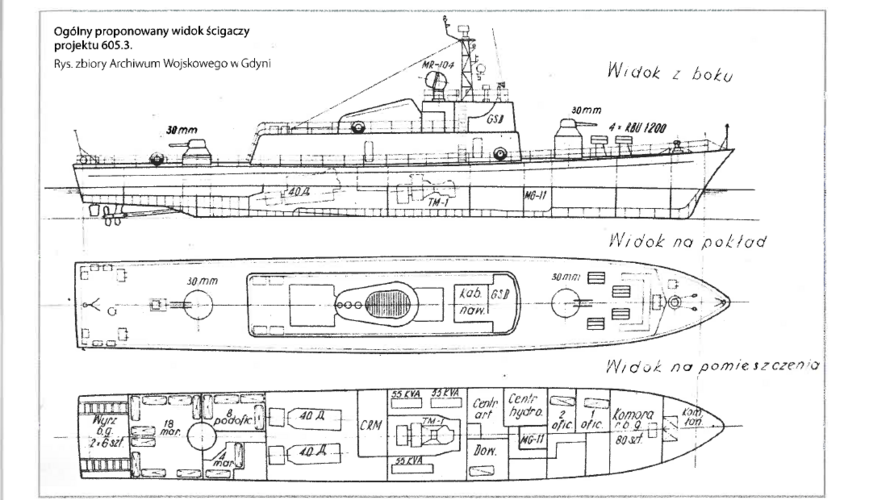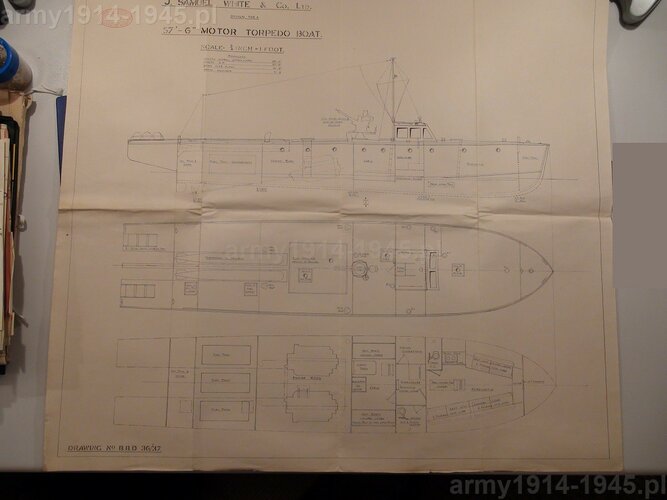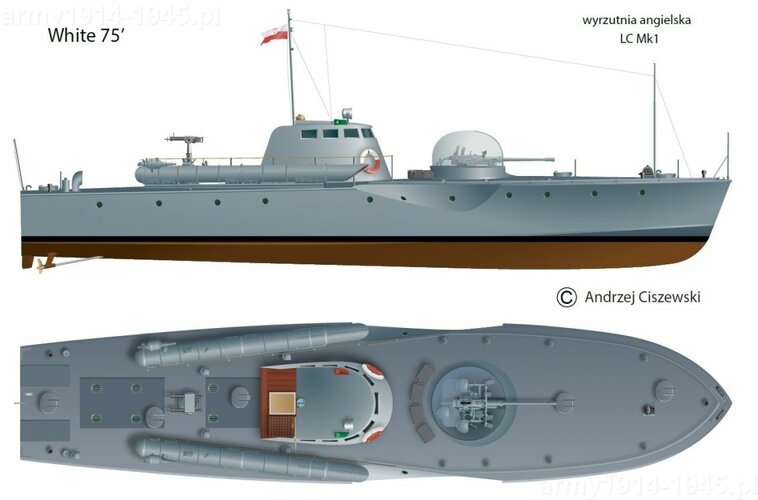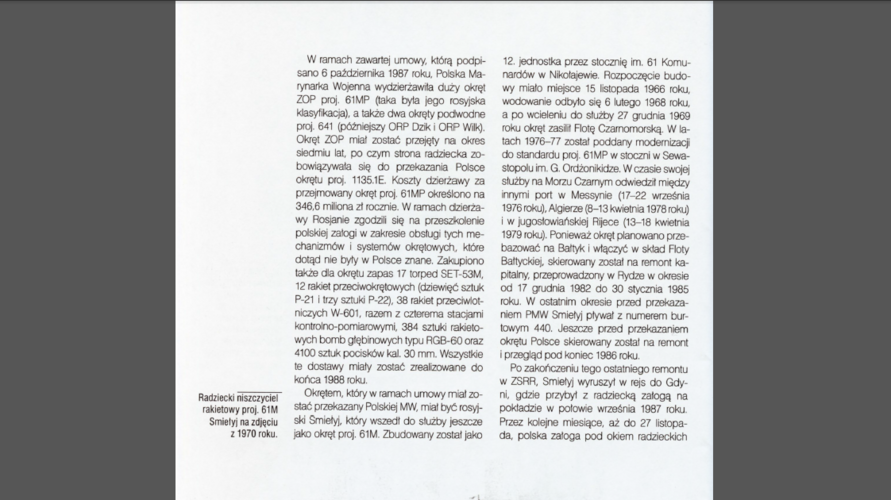USSEssex
ACCESS: Confidential
- Joined
- 11 May 2021
- Messages
- 152
- Reaction score
- 266
About frigates from Poland.
Few of you know that frigates were designed in Poland after the war.
In this post, I will try to introduce you to some of them.
After the October thaw, in 1956 dreamed of frigates, so ships of this class had been designed since the 1950s.
The first such project that I think is worth writing about and which I know is project 603 from 1956.
project 603, codenamed Bryza, was a ship to search for and combat submarines, to carry out close and distant surveillance, to lay minefields and to defend convoys.
It was to have a displacement of 850 tons
top speed of 36 knots
cruising range 3500 nautical miles at 15-18 knots of economic speed.
His armament is
2xII automatic guns caliber 100 mm with fire control radar (or ship-ship and land-air missile launchers)
2xII automatic 57 mm guns with their own fire control radar
1xIII 533 mm torpedo tube,
MBU 600 depth charge rocket launchers,
stern depth charge launchers,
4 broadside launchers of classic depth charges
and deep sea tracks at the stern.
Project 603.1 and project 603.2 did not differ much because the differences are in the propulsion system.
Project 603.1 was to have a three-shaft power plant with 2 FIAT diesel engines and 4x TM 1 gas turbines with subversions that differed in the arrangement of individual elements.
Project 603.2
a two-shaft variant was envisaged.
4 FIAT engines and 2 turbines
or three-shaft 4 gas turbines of 2 types.
In 1958, the concept was presented to the Soviets, they recommended developing technical documentation as soon as possible and building a prototype by 1965, but they said that there would be no twin 100 mm guns in the near future.
The work lasted until 1960.
Sometimes this ship is written as a large submarine chaser (de facto corvette) and sometimes a frigate.
Another of the frigate projects.
Project 610 small frigate
standard displacement
750 tons
total length 66.2 m
width 9.7 m
draft 2.8 m
armament
1 x Osa-M
2 × AK-230
2 x RBU-2500
2xI torpedo tubes with firing control system
Ship's propulsion
4 engines 40D
2 × TM-1
Speed is 31 knots.
Another project of a small frigate is project 611.
Standard displacement is 770 tons
total length 66.2 m
width 9.7 m
Draft 2.9 m
Armament
1 x II 57mm ZIF-31B gun
2 × AK-230
2 x RBU-2500
2 × I torpedo tubes with firing control system
Top speed 30.5 knots.

In fact, after the war, everything was designed in Poland, from torpedo boats to patrol ships, ending with frigates, the only thing not designed in Poland were battleships, cruisers, destroyers and submarines.
and there are a lot of these projects.
I can add not-so-called projects Potyrała are not projects, but I will explain it later.
Few of you know that frigates were designed in Poland after the war.
In this post, I will try to introduce you to some of them.
After the October thaw, in 1956 dreamed of frigates, so ships of this class had been designed since the 1950s.
The first such project that I think is worth writing about and which I know is project 603 from 1956.
project 603, codenamed Bryza, was a ship to search for and combat submarines, to carry out close and distant surveillance, to lay minefields and to defend convoys.
It was to have a displacement of 850 tons
top speed of 36 knots
cruising range 3500 nautical miles at 15-18 knots of economic speed.
His armament is
2xII automatic guns caliber 100 mm with fire control radar (or ship-ship and land-air missile launchers)
2xII automatic 57 mm guns with their own fire control radar
1xIII 533 mm torpedo tube,
MBU 600 depth charge rocket launchers,
stern depth charge launchers,
4 broadside launchers of classic depth charges
and deep sea tracks at the stern.
Project 603.1 and project 603.2 did not differ much because the differences are in the propulsion system.
Project 603.1 was to have a three-shaft power plant with 2 FIAT diesel engines and 4x TM 1 gas turbines with subversions that differed in the arrangement of individual elements.
Project 603.2
a two-shaft variant was envisaged.
4 FIAT engines and 2 turbines
or three-shaft 4 gas turbines of 2 types.
In 1958, the concept was presented to the Soviets, they recommended developing technical documentation as soon as possible and building a prototype by 1965, but they said that there would be no twin 100 mm guns in the near future.
The work lasted until 1960.
Sometimes this ship is written as a large submarine chaser (de facto corvette) and sometimes a frigate.
Another of the frigate projects.
Project 610 small frigate
standard displacement
750 tons
total length 66.2 m
width 9.7 m
draft 2.8 m
armament
1 x Osa-M
2 × AK-230
2 x RBU-2500
2xI torpedo tubes with firing control system
Ship's propulsion
4 engines 40D
2 × TM-1
Speed is 31 knots.
Another project of a small frigate is project 611.
Standard displacement is 770 tons
total length 66.2 m
width 9.7 m
Draft 2.9 m
Armament
1 x II 57mm ZIF-31B gun
2 × AK-230
2 x RBU-2500
2 × I torpedo tubes with firing control system
Top speed 30.5 knots.

In fact, after the war, everything was designed in Poland, from torpedo boats to patrol ships, ending with frigates, the only thing not designed in Poland were battleships, cruisers, destroyers and submarines.
and there are a lot of these projects.
I can add not-so-called projects Potyrała are not projects, but I will explain it later.
Last edited:















